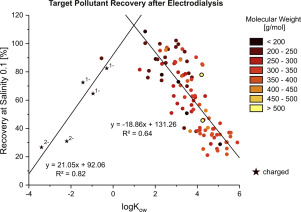Marine Chemistry ( IF 3 ) Pub Date : 2019-10-31 , DOI: 10.1016/j.marchem.2019.103719 M.A. Wirth , M. Sievers , F. Habedank , U. Kragl , D.E. Schulz-Bull , M. Kanwischer

|
Electrodialysis (ED) is an advancing seawater sample processing tool that enables the separation of analytes from the often interfering salt matrix. In this study, we present the evaluation of a laboratory scale ED system for both dissolved organic matter (DOM) and target pollutant analysis of seawater.
The developed sample processing protocol yields reproducible data and was found to be robust towards moderate changes in sample composition. At the final salinity of 0.1, the average recovery of DOM in the form of dissolved organic carbon, nitrogen and phosphorus (DOC, DON and DOP) was 44, 53 and 89%, respectively. DOM loss occurred mainly in the late stage of the ED process.
When investigating specific ED processing parameters, it was discovered that the initial sample salinity does not influence DOM recovery. The final salinity, by contrast, is a dominant influence factor on DOM recovery. Furthermore, DOC and DOP recoveries could be improved by 8% by refining the electrical current in the ED cell. Surprisingly, adjustments of the sample pH did not lead to any improvements in DOM recovery.
The experiments with target analytes showed that the recovery of individual molecules is determined by their n-octanol water partition coefficients logKow. High recoveries > 80% were achieved for compounds with medium logKow of −1 to 3. Hydrophobic compounds with logKow > 3 were lost through surface adsorption to the system walls and tubing. Small, polar and charged compounds with logKow < −1 are prone to loss via ED membrane passage, which occurred predominantly in the late stage of the ED process. Consequently, sample processing with ED was deemed beneficial for the LC-MS or GC–MS analysis of polar target compounds, because they are often difficult to enrich from seawater. Furthermore, during LC-MS or GC–MS analyses, matrix-dependent ion suppression was reduced in ED isolates, giving rise to increased signal responses of 25 to 620%, which resulted in improved instrumental sensitivity.
中文翻译:

电渗析作为海水中大量有机物和目标污染物分析的样品处理工具
电渗析(ED)是一种先进的海水样品处理工具,能够从经常干扰的盐基质中分离出分析物。在这项研究中,我们介绍了实验室规模的ED系统对溶解性有机物(DOM)和目标海水污染物分析的评估。
已开发的样品处理方案可产生可重复的数据,并被发现对样品成分的适度变化具有鲁棒性。在最终盐度为0.1时,溶解有机碳,氮和磷(DOC,DON和DOP)形式的DOM的平均回收率分别为44%,53%和89%。DOM丢失主要发生在ED过程的后期。
在研究特定的ED处理参数时,发现初始样品盐度不影响DOM的回收率。相比之下,最终盐度是DOM恢复的主要影响因素。此外,通过优化ED电池中的电流,可以将DOC和DOP的回收率提高8%。出人意料的是,样品pH的调整并没有导致DOM回收率的任何提高。
与靶分析物的实验表明,单个分子的回收可以通过确定Ñ辛醇-水分配系数的logK流。logK ow为-1到3的中等化合物的回收率达到80%以上。logK ow > 3的疏水性化合物通过表面吸附到系统壁和管道中而损失掉。具有logK ow的小,极性和带电化合物 <-1易于通过ED膜通过而损失,这种损失主要发生在ED过程的后期。因此,用ED处理样品被认为有利于极性目标化合物的LC-MS或GC-MS分析,因为它们通常很难从海水中富集。此外,在LC-MS或GC-MS分析过程中,ED分离物的基质依赖性离子抑制作用降低,信号响应增加25%至620%,从而提高了仪器灵敏度。



























 京公网安备 11010802027423号
京公网安备 11010802027423号